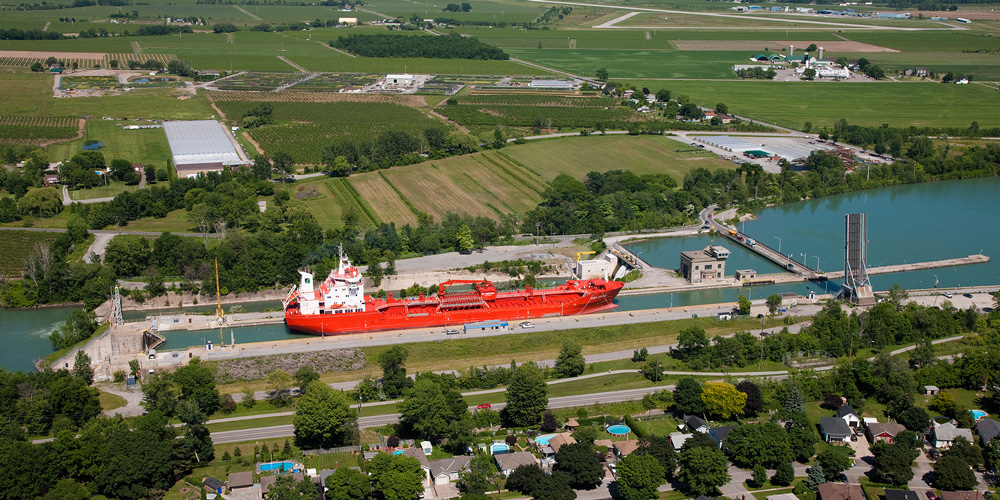Seaway Activity Bursts Past 40 Million Tonnes in 2018
January 17, 2019
Best Grain Results since the Turn of the Century
Cornwall, Ontario (January 17, 2019) – The St. Lawrence Seaway Management Corporation (SLSMC) announced today that tonnage on the waterway during the 2018 navigation season totaled 40.9 million tonnes. The highest result since 2007, much of the credit for the increase in tonnage can be given to healthy movements of grain, the best on record since the turn of the century. Marketing efforts under the “Highway H2O” initiative served as a catalyst to spur increased movements of a broad range of cargoes including grain, road salt, stone, cement, gypsum and refined fuels.
“We are very pleased with the results recorded over the past year” said the SLSMC’s President and CEO, Terence Bowles. “After completing the first year with Hands Free Mooring installed at all of our high-lift locks, it is gratifying to see that our efforts to boost system efficiency and heighten our competitive position are bearing strong results. This new mooring technology eliminates the need for special vessel fittings, enabling the St. Lawrence Seaway to welcome a broader range of ships from the world fleet.”
Craig H. Middlebrook, Deputy Administrator of the U.S. Saint Lawrence Seaway Development Corporation said, “Total tonnage on the St. Lawrence Seaway exceeded the 5-, 10-, and 15-year averages, making 2018 an exceptionally strong shipping season, the best in over a decade. In particular, we were pleased to see heightened activity on the Seaway in December. Overall gains in year-over-year commodity increases were widespread, most notably in U.S. grain export trade. The investments in Seaway infrastructure and technology are achieving greater efficiencies for our customers and enhancing the binational waterway’s global competitiveness.”
The 2018 navigation season concluded on December 31st, with the transit of the Cedarglen through the Welland Canal’s Lock 8 at 12:35, heading for Lake Erie. In the Montreal sector, the M.V. Floragracht was the last ship to transit, clearing the St. Lambert Lock at 19:45 on December 30th as she proceeded on her voyage to Europe.
The St. Lawrence Seaway enables cargo to move within North America and also serves as a vital international gateway, supporting trade with more than 50 countries across the globe. Since its opening in 1959, almost 3 billion tonnes of cargo valued at over $450 billion has moved through the St. Lawrence Seaway’s 15 locks.
The recent completion of the The St. Lawrence Seaway Management Corporation’s modernization program, which includes Hands Free Mooring and remote operation of locks from centralized operation control centres, represents the greatest advancement in Seaway operations since its inception in 1959. As a result, the Seaway has become even more competitive. With the elimination of tie-up lines for most vessels, Seaway employees and vessel crews face fewer safety risks and vessels experience less “wear and tear” as they enter and exit locks.
“The SLSMC continues to take a leadership role in the utilization of technology to better serve our customers. With strong advancements in efficiency, safety and flexibility, the stage has been set for a St. Lawrence Seaway that will effectively serve its stakeholders for decades to come. As we prepare to celebrate the Seaway’s 60th anniversary at our 2019 season opening, and take stock of the progress made, we can truly say that we are ready for the future!” said CEO Bowles.
Quick Facts:
- The Great Lakes St. Lawrence River System is a “marine highway” that extends some 3,700 km from the Atlantic Ocean to the Great Lakes. Over 200 million tonnes of cargo travels over the System on an annual basis, supporting over 329,000 jobs and $59 billion in economic activity in Canada and the United States.
- The binational St. Lawrence Seaway serves as the linchpin within the broader waterway, connecting the lower St. Lawrence River to the Great Lakes. Beginning in Montreal and extending to points west, the Seaway’s 15 locks (13 Canadian and 2 U.S.) enable ships to climb a total of 168 metres from “sea level” up to Lake Erie. For more information on the St. Lawrence Seaway, please consult www.greatlakes-seaway.com.
About The St. Lawrence Seaway Management Corporation:
- The St. Lawrence Seaway Management Corporation was established in 1998 as a not-for-profit corporation by the Government of Canada, Seaway users and other key stakeholders. In accordance with provisions of the Canada Marine Act, the Corporation manages and operates the Canadian assets of the St. Lawrence Seaway, which remain the property of the Government of Canada, under a long-term agreement with Transport Canada.






